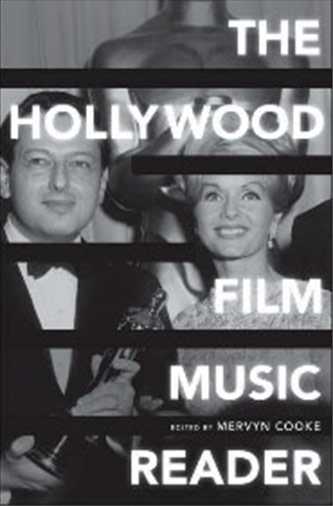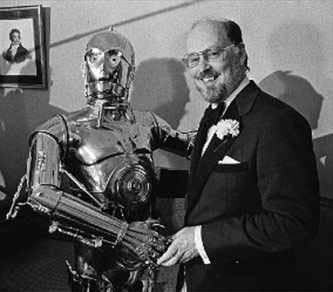American Music Review
Vol. XL, No. 2, Spring 2011
By Jordan Stokes
Mervyn Cooke's The Hollywood Film Music Reader (Oxford University Press, 2010) is not, as the title might suggest, a collection of scholarly literature on the topic (as is, to cite a single example, Kay Dickinson's recent Movie Music, The Film Reader).1 Rather, it is a sort of documentary history containing first-hand accounts by and interviews with people who were engaged in the practical business of film music, and a few critical essays chosen for their historical signficance. A number of Cooke's selections are no longer in print elsewhere, which is in itself reason enough to celebrate the publication of this volume. But for a documentary history of Hollywood film music, it manages to be both ambitiously broad—spanning from the silent era through to the end of the twentieth century—and surprisingly narrow.
From the indispensable survey articles of Martin Marks (1979), Robynn Stilwell (1996), and Desmond Maley (2010), the following list of categories of film music writing emerge: 1) instructional manuals or aids for the preparation of film music, 2) writings on sound and music by film theorists, 3) popular accounts of film music practice addressed to the general public (often written by composers, and leavened with colorful autobiographical anecdotes), 4) journalistic discussions of music, typically with a focus on contemporary films, 5) synoptic accounts of film music's theory and history (either popular or scholarly), and 6) scholarly studies of individual films and specific topics such as scoring techniques and style criticism.2 Although several of these areas are touched on in passing, only the third category is well represented in Cooke's collection. Instead of attempting to present the entire corpus of writings on film music in microcosm, the book is overwhelmingly and intentionally skewed towards writings by composers.

The Hollywood Film Music Reader by Mervyn Cooke Cover Image
Of the three broad sections, "From ‘Silents' to Sound," "Film Composers in Their Own Words," and "Critics and Commentators," the second is by far the largest, weighing in at 208 pages out of a total of 359. The "Silents' to Sound" section is allowed a mere 47 pages, the "Critics and Commentators," 102. These so-called critics include George Antheil, Igor Stravinsky, David Raksin, Hanns Eisler (writing with Adorno), Aaron Copland, and Elmer Bernstein. Only three of the critical selections were written by individuals not known primarily as composers. One is by conductor/composer/new-music-advocate Lawrence Morton, who worked sporadically as a Hollywood orchestrator. A second is by director Sidney Lumet. Just one essay in this section, Frederick Sternfeld's article on Hugo Friedhofer's The Best Years of Our Lives score, was written by a scholarly critic. The brief "From ‘Silents' to Sound" section is somewhat more balanced, including pieces by music publisher Max Winkler, journalist T. Scott Buhrman, organist Gaylord Carter, conductor/ composer Ernö Rapée, and composer/musicologist Leonid Sabaneev. Still, the overall focus on the writings of composers is clearly felt throughout.
Film composers obviously have fascinating things to say about film music and Marks considered them to have made the greatest contribution to the literature at the time of his writing. More vexing, however, is the predominance of big-name composers. Did we really need two passages from Copland? Is our knowledge of Hollywood film music really best served by reading Stravinsky, who wrote no film scores?
The focus on composers, if not the focus on famous names, is in line with Cooke's acknowledged intention to "offer enthusiasts of the subject a vivid reminder of the altogether more down-to-earth experiences of those whose hard work laid the foundations for the rich legacy of film-scoring practices from which movie-goers benefit today." (vii) This is a laudable goal. Despite some notable and occasionally heroic exceptions, the scholarly discipline of film music studies has been more concerned with understanding the experience of film music (critical readings, analyses) than with understanding the production of film music (histories, economic studies, biographies). One of the great challenges facing film music studies today is the scholarly contingent's lack of engagement with the actual process of film music composition. Perhaps the tendency to view the film score as a transcendent work of art is a natural consequence of defending a music that has so often been damned for lack of artistic merit. But this can cause us to forget that film music, like all music, depends on the efforts of real people involved in a complex and messy production process. From this perspective, Cooke's stubbornly production-centered selections could be seen as a necessary corrective, though one that emphatically valorizes the composer at the expense of orchestrators, conductors, performers, recordists, sound editors, directors, and even studio power brokers such as Samuel Goldwyn and David O. Selznick. The latters' correspondence with their heads-of-music-departments would surely be of great interest to any scholar of the golden age Hollywood sound. To be fair, a good amount of information about the collaborative process of scoring can be gleaned from some of the composers' accounts included here—Adolph Deutsch is particularly helpful—but it is always at a remove, and the various studio figures are usually cast in an adversarial light. The story of the plucky composer who sticks to his guns and triumphs over the Hollywood philistines is surely a compelling one, but shouldn't we hear it from both sides?

Star Wars Soundtrack Composer John Williams and C-3PO
These criticisms should not detract from the book's considerable merits, particularly its focus and depth. Had the book attempted to cover all of the categories of film music literature listed above, or indeed all of the studio professions, it would have had to shortchange many of them. By exploring only the writings of composers, it provides a broad and nuanced account of what film composers think and do. The picture that emerges is anything but monolithic; each of the featured writers has his own ideas about film composition, and each passage selected by Cooke has it own particular focus. So there is room for Lawrence Morton's thoughts on orchestration, John Williams' on designing leitmotifs, Thomas Newman's on integrating samples and electronic instruments, and Max Steiner's on clearing the rights to preexisting works. Where most discussions of film music focus only on narrative live-action films, here we find three extensive treatments of scoring for cartoons. Some topics are the subject of clearly focused essays, while others come up almost incidentally in the course of a wide-ranging discussion. But nearly all of the selections are highly informative about some aspect of the process.
Cooke has also chosen compellingly readable sources; Raksin and Antheil in particular are remarkable prose stylists. Cooke's own introductory notes for each essay are clear and engaging, and effectively place the material in historical context. There are a couple of lacunae—we learn nothing of Sabaneev's biography save that he wrote in Russian—but for the most part the materials are admirably framed.
Someday, someone will compile a book of source readings that can serve as the foundation for a graduate course on the history or theory of Hollywood film music. This is not that book. But if it is no foundation, it makes for an attractive flying buttress. Rather than speculating about the ideal book that might have been, we ought to ask more about the book that we are presented with. Is it instructive to review Copland's categories of film music effects? Is it enlightening to hear Waxman talk about writing music from inside a character? Is it pleasant to reminisce with Gaylord Carter about the golden age of the cinema organist? Is it droll to sit at Antheil's shoulder while he screens Un Chien Andalou for "Cecil B. de Mille, king of the surrealists (American branch)"? (264) Will it be helpful for scholars to have these writings, and others, easily at hand in an attractive, well-edited, and well-printed edition? The answer to all of these questions is yes, and Cooke'sHollywood Film Music Reader is highly recommended.
—Jordan Stokes
CUNY Graduate Center
Notes
- 1 Kay Dickinson, Movie Music: The Film Reader (London: Routledge, 2003).
- 2 Martin Marks, "Film Music: The Material, Literature and Present State of Research," Notes 36 (1979): 282–325. Robynn Stilwell, "Music in Films: A Critical Review of Literature, 1980–1996," The Journal of Film Music1, no. 1 (1996): 19–61. Desmond Maley, "A Librarian's Reflections on the Emerging Bibliography of Film Music," CAML Review/Revue de l'ABCM 38, no. 2 (2010): 21–32.






